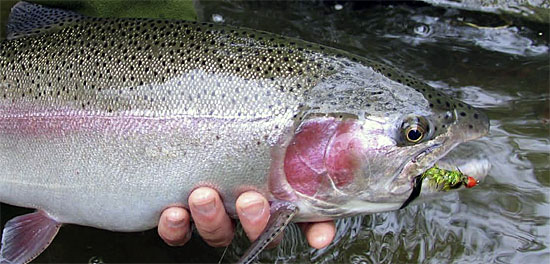The Right Gear for Large Alaskan Rainbows
Have a question you want answered? Email it to us at [email protected].
Question: I want to travel to the Bristol Bay region of Alaska specifically to catch large rainbows, rather than salmon. What do I need to know about tackle?
Graham B., American Canyon, CA

Joe Phillips photo
Answer: My first piece of advice is to talk to the guides you’re planning to fish with. They’ll be best able to gauge the specific requirements of their home waters. That said, here are some general tips.
I was lucky enough to guide for a season on the Copper River, which empties in Lake Iliamna on the Alaska Peninsula. It’s a non-glacial river, which means that the water is clear, and the river features incredible insect life (including the largest stonefly hatch I’ve ever seen). As a result, the Copper offers some of the most consistent dry-fly fishing for big rainbows in the Last Frontier. Catching a 25-inch wild Alaskan rainbow on a size 12 Stimulator is a great experience, which I highly recommend.
However, because the weather is so variable and the wind can almost blow you off the water, you can’t really count on dry-fly action in any given week; hitting a hatch is really down to luck. And virtually all surface action ends once the sockeyes show up in astonishing numbers. At first, the salmon simply displace the trout and push them around, but once there are salmon eggs in the water, you can’t even get a trout to look upward. Chances are, unless you are planning on fishing the first few weeks of the season, you’ll be fishing subsurface with streamers and egg patterns.
My fellow guides and I had a motto: “We fish big rainbows, therefore we dredge.” Your goal is to get your fly to the bottom quickly. You’ll need a rod that can handle a size 2 Conehead Woolly Bugger, fished on a sinking tip and cast into the teeth of a 30-knot wind. Depending on your skill and comfort as a caster, you may use a 6-, 7-, or 8-weight. Don’t just run out and buy the stiffest rod you can find, though; such rods often offer less control when the line is in the air, and you don’t want to clock yourself in the head with a giant tungsten projectile. Take the time to choose a rod that offers the most power for your particular casting stroke.
Interchangeable sinking tips—of various sink rates and with loop-to-loop connections—are a good idea because they allow you to adjust for water depth and speed. Egg-stuffed trout will often refuse to move more than a few inches out of their way to eat something, so you’ve got to bang them on the nose.
The same holds true when you are drifting egg patterns. The longer the salmon have been in the river laying eggs, the lazier the trout get. People imagine that Alaska fishing is always easy, but there are times when only a perfect dead-drift will draw a strike—and then only if you drift the fly straight down the trout’s ever-narrowing feeding lane. So you’ll want a nymphing rod long enough to give you good line control and sensitive enough to detect subtle strikes. That super-fast stick that might help you punch the line through the wind may become a liability once the fly is in the water. I always preferred a 9-foot, medium- to medium-fast-action 6-weight for drifting eggs. This rod will also be good for dry-fly fishing should you encounter rising fish.











